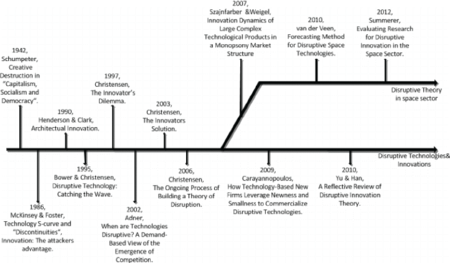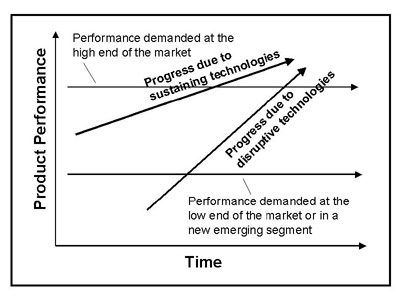Disruptive Technology
What is Disruptive Technology?
The term disruptive technology was coined by Clayton M. Christensen and introduced in his 1995 article Disruptive Technologies: Catching the Wave which he cowrote with Joseph Bower. He describes the term further in his book The Innovator's Dilemma. Christensen describes two types of technologies: sustaining technologies and disruptive technologies. Sustaining technologies are technologies that improve product performance. These are technologies that most large companies are familiar with; technologies that involve improving a product that has an established role in the market. Most large companies are adept at turning sustaining technology challenges into achievements. Christensen claims that large companies have problems dealing with disruptive technologies. Disruptive technologies are "innovations that result in worse product performance, at least in the near term." They are generally "cheaper, simpler, smaller, and, frequently, more convenient to use." Disruptive technologies occur less frequently, but when they do, they can cause the failure of highly successful companies that are only prepared for sustaining technologies. Disruptive technologies cause problems because they do not initially satisfy the demands of even the high end of the market. Because of that, large companies choose to overlook disruptive technologies until they become more attractive profit-wise. Disruptive technologies, however, eventually surpass sustaining technologies in satisfying market demand with lower costs. When this happens, large companies that did not invest in the disruptive technology sooner are left behind. This, according to Christensen, is the "Innovator's Dilemma."[1]
In his sequel with Michael E. Raynor, The Innovator's Solution, Christensen replaced the term disruptive technology with disruptive innovation because he recognized that few technologies are intrinsically disruptive or sustaining in character; rather, it is the business model that the technology enables that creates the disruptive impact.[2]
Without fixating on the current academic discourse, there are several key points about disruptive technologies:
- they tend to be developed by outsiders and entrepreneurs rather than market leaders as they are not sufficiently profitable at first and could detract from sustaining innovation: as a result, disruptive technologies can take longer to develop and be higher risk, yet achieve much faster penetration when they finally impact on the market.
- large companies know their markets, stay close to their customers and develop existing technology — in contrast, they often fail to capitalize on disruptive technology, which can initially lack refinement or have performance problems.
- disruption affects processes as well as products — in other words, changing how we do something is just as important as the new technology that enables us to do it. It is rare that technology is inherently disruptive disruption usually occurs when a low-margin technology (or combination of technologies) is applied to a new market at a lower price.
- there can be multiple disruptive technologies across the industry, some of which are competing.
- despite the apparently chaotic nature of change, some developments are to some extent predictable — this is particularly the case where technological progress is contingent on a previous development[3]
Evolution of Disruptive Technology
Below is a diagrammatic representation of the evolution of Disruptive Technology

source: Dimitrios Giannoulas
Stages of Disruption[4]
- Phase One: Disruption of Incumbent: When a new product, service, or technology becomes available, a moment of disruption occurs. Be aware that denial may be part of this stage as disruption often means using inferior and more expensive technologies. Sinofsky’s advice is to search for evidence to back your disruption.
- Phase Two: Rapid Linear Evolution: Once that new product, service, or technology begins rapid adoption, it’s time to focus on “filling out” the product. During this phase, the disruptors continue to follow their vision and continue to innovate.
- Phase Three: Appealing Convergence: Sinofsky describes this phase as the point when the new product starts to undergo a subtle redefinition. The early adopters described in phase two are now a maturing group and develop a sense of stability.
- Phase Four: Complete Reimagination: The last stage of disruption occurs when the technology is reimagined from the ground up. It may seem like just another disruption, but remember, it is a unique stage because of responses from the legacy incumbent and disruptor.

source: Shane Wall
Disruptive Technology Trends[5]
- Energy storage: In the book, No Ordinary Disruption: The Four Global Forces Breaking All the Trends, the authors predict that the price of lithium-ion battery packs could fall by a third in the next 10 years, which will have a big impact on not only electric cars but renewable energy storage. There will be major repercussions for the transportation, power generation, and the oil and gas industries as batteries grow cheaper and more efficient.
- Genomics: As supercomputers make the enormously complicated process of genetic analysis much simpler, the authors foresee a world in which “genomic-based diagnoses and treatments will extend patients’ lives by between six months and two years in 2025.” Sequencing systems could eventually become so commonplace that doctors will have them on their desktops.
- Advanced materials: The ability to manipulate existing materials on a molecular level has already enabled advances in products like sunglasses, bike frames, and medical equipment. Scientists have greater control than ever over nanomaterials in a variety of substances, and their understanding is growing. Health concerns recently prompted Dunkin’ Donuts to remove nanomaterials from their food. But certain advanced nanomaterials show promise for improving health, and even treating cancer. Coming soon: materials that are self-healing, self-cleaning, and that remember their original shape even if they’re bent.
- Autonomous vehicles: Autonomous cars are coming, and fast. By 2025, the “driverless revolution” could already be “well underway,” the authors write. All the more so if laws and regulations in the U.S. can adapt to keep up. Case in point: Some BMW cars already park themselves.
- Renewable Energy: Wind and solar have never really been competitive with fossil fuels, but McKinsey predicts that the status quo will change thanks to technology that enables wider use and better energy storage. In the last decade, the cost of solar energy has already fallen by a factor of 10, and the International Energy Agency predicts that the sun could surpass fossil fuels to become the world’s largest source of electricity by 2050.
- Advanced Robotics: The robots are coming! “Sales of industrial robots grew by 170% in just two years between 2009 and 2011,” the authors write, adding that the industry’s annual revenues are expected to exceed $40 billion by 2020. As robots get cheaper, more dexterous, and safer to use, they’ll continue to grow as an appealing substitute for human labor in fields like manufacturing, maintenance, cleaning, and surgery.

source: McKinsey Global Institute
3D Printing: Much-hyped additive manufacturing has yet to replace traditional manufacturing technologies, but that could change as systems get cheaper and smarter. “In the future, 3D printing could redefine the sale and distribution of physical goods,” the authors of the above-noted book say. Think of buying an electric blueprint of a shoe, then going home and printing it out. The book notes that “the manufacturing process will ‘democratize’ as consumers and entrepreneurs start to print their own products.”
- Mobile Internet: The explosion of mobile apps has dramatically changed our personal experiences (goodbye hookup bars, hello Tinder), as well as our professional lives. More than two-thirds of people on earth have access to a mobile phone, and another two or three billion people are likely to gain access over the coming decade. The result: internet-related expenditures outpace even agriculture and energy, and will only continue to grow.
- Automation of Knowledge Work: It’s not just manufacturing jobs that will be largely replaced by robots and 3D printers. Dobbs, Manyika, and Woetzel report that by 2025, computers could do the work of 140 million knowledge workers. If Watson can win at “Jeopardy!” there’s nothing stopping computers from excelling at other knowledge work, ranging from legal discovery to sports coverage.
- Internet of Things: Right now, 99% of physical objects are unconnected to the “internet of things.” It won’t last. Going forward, more products and tools will be controlled via the internet and all kinds of data will be generated as a result. Expect sensors to collect information on the health of machinery, the structural integrity of bridges, and even the temperatures in ovens.
- Cloud Technology: The growth of cloud technology will change just how much small businesses and startups can accomplish. Small companies will get “IT capabilities and back-office services that were previously available only to larger firms—and cheaply, too." Large companies in almost every field are vulnerable, as start-ups become better equipped, more competitive, and able to reach customers and users everywhere.”
- Advanced oil and gas exploration and recovery: The International Energy Agency predicts the U.S. will be the world’s largest producer of oil by 2020, thanks to advances in fracking and other technologies, which improved to the point where removing oil from hard-to-reach spots finally made economic sense. McKinsey directors expect increasing ease of fuel extraction to further shift global markets.
See Also
References

